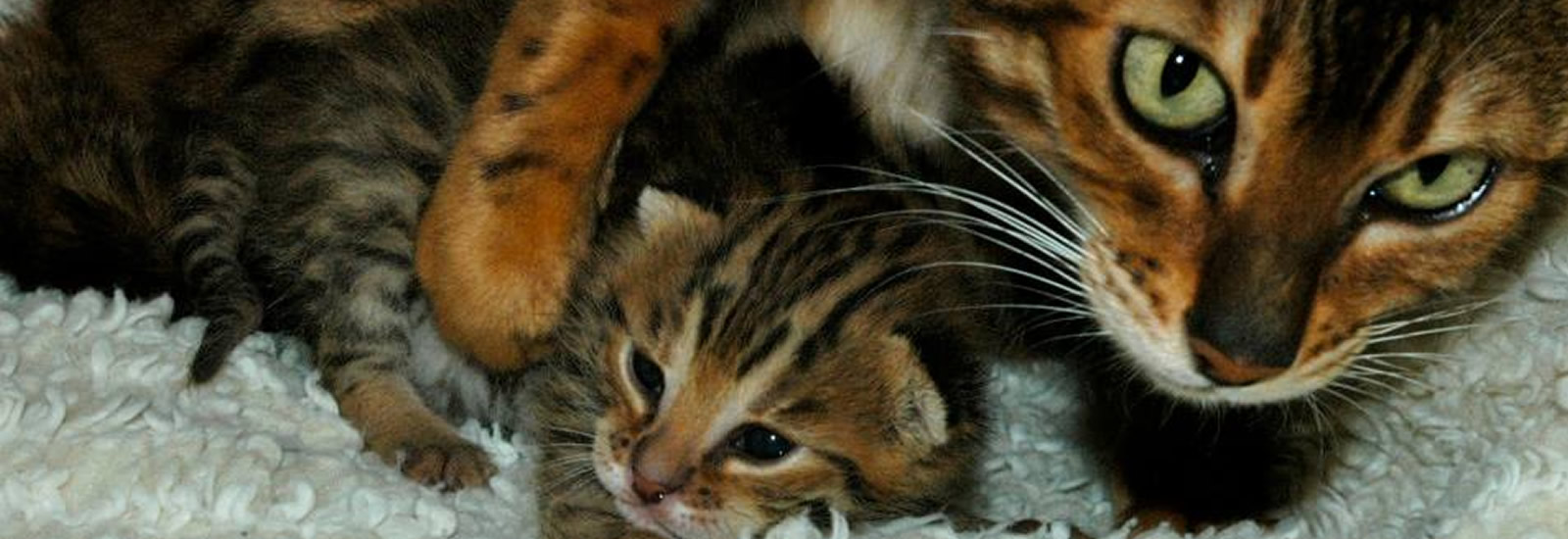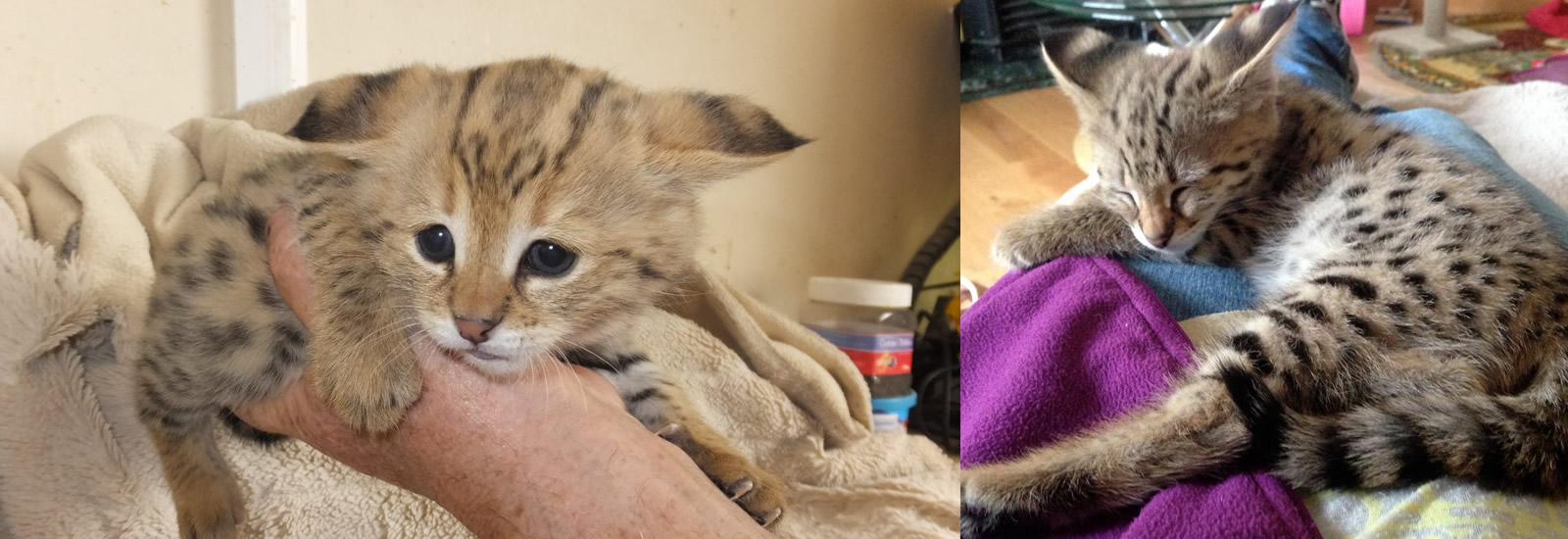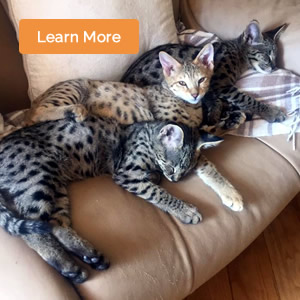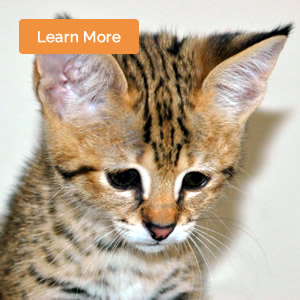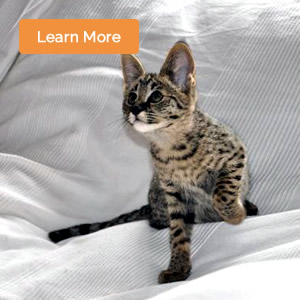The Leopard Mimics -
F1 and F2 Bengals
By C. Esmond Gay - Sarez Bengals - 2004
In 1960’s America, Jean Mill and other breed pioneers crossed leopard cats with domestic cats, producing F1 and F2 Bengals; creatures that are the paragons of beauty, the epitome of both species - they harmoniously capture the appearance and characteristics of the wild leopard, and can also have gentle and enchanting personalities. Our early generation Bengals changed our lives forever, creating bonds that transcend species. This article details the wonders of living with these, the quintessential generations of the Bengal cat, and much of what we’ve learnt.
Living with F1 Bengals
Thanks to their mixed heritage, Filial 1 (F1) hybrids are the most captivating and intriguing generation of the Bengal cat. Their beauty is legendary and with elegance that embodies all the grace and poise of a prima ballerina, together with the sophisticated looks of a supermodel, they could easily hold their own on the world’s most prestigious catwalks!
Baby Gem (F1 Female) -
Summer of 1995 
The inexperienced tend to assume that F1s are temperamental and unfriendly, but the contrary is true - the domestic blood mix combined with a lot of handling from kittenhood, normally ensures that they grow up to be as loving and docile as late generation F4 Bengals and onwards (known as Stud Book Traditions or SBTs). However, as nature does not have any rules on how much wild blood and how much domestic blood a hybrid can inherit, some F1s can be more predisposed to the leopard cat side than to their domestic parent, and vice versa.
F1s are also very intelligent due to the heightened natural instincts they inherited from their wild leopard cat father, and this means that they can be more sensitive compared to normal house cats, in the same sort of way that a 4 year old child is. These traits make F1s very much one-family cats and in most instances they passionately attach themselves to one person in particular in the home (but happily tolerate the others). F1 males normally bond closely to the female human whilst F1 females become attached to the male human. This occurs in most hand-reared wild cat species and we’ve found such behaviour common in our ocelots, servals and leopard cats - however, it doesn’t really happen with domestics.
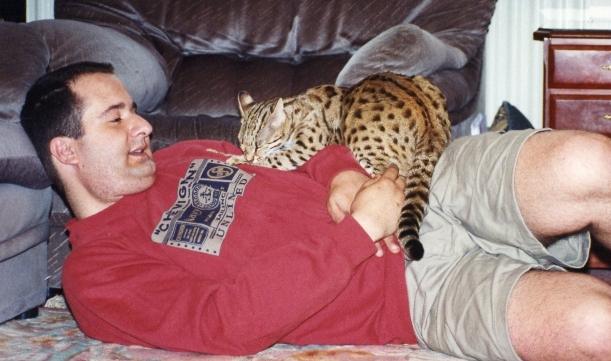 All
our F1s, from our first three, Occie,
Leopardette (Nyali Jungle Song) and
Baby Gem (Nyali Baby Baby), to the ones we
later bred ourselves, are the most wondrous of pets. Occie,
our male, took to Sarah as soon as we bought him and he behaves like
an adoring puppy with her. She can do anything with him and only has
to call his name and he will come running to her and follow her
around, trying to jump up at her so that he can lick her face and
suckle her fingers! The press have always been mesmerised by the
relationship between this pretty young lady and a 50% wild cat
hybrid, and photos of him affectionately kissing Sarah on the lips
have adorned the pages of many national newspapers.
All
our F1s, from our first three, Occie,
Leopardette (Nyali Jungle Song) and
Baby Gem (Nyali Baby Baby), to the ones we
later bred ourselves, are the most wondrous of pets. Occie,
our male, took to Sarah as soon as we bought him and he behaves like
an adoring puppy with her. She can do anything with him and only has
to call his name and he will come running to her and follow her
around, trying to jump up at her so that he can lick her face and
suckle her fingers! The press have always been mesmerised by the
relationship between this pretty young lady and a 50% wild cat
hybrid, and photos of him affectionately kissing Sarah on the lips
have adorned the pages of many national newspapers.
Esmond Gay & Leopardette (F1 Female) Suckling Her Paw - Circa August 1995
Likewise, Leopardette and Baby Gem, our first two F1 females, attached themselves to me; I will never forget the first day I brought Leopardette home. She was 18 months old and although hand-reared like her siblings, her original owner hadn’t really given her that much attention in her adulthood as Baby Gem had been his favourite. So I wasn’t expecting much, just a timid, confused animal who would take a long time to settle in - yet when I let her out of the cat carrier, instead of dashing to hide, Leopardette ran around and around me, purring loudly… and then she did the cutest thing - she jumped on my knee, started to knit frenziedly and suckled her own paw at the same time - so endearing. This went on for hours and by the time I left the room, I was absolutely besotted with her - and vice versa! And to this day, every time Leopardette sees me, she does the same, obviously reliving the comfort she felt when suckling during her kittenhood.
Baby Gem (F1 Female) -
Circa August 1995 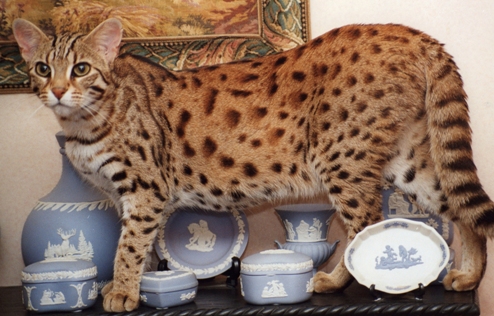
Considering that we bought these F1s as adults, we realise that such extreme affection from them is a privilege as it should have been harder for them to adjust to our home. The deeply loving relationships that we enjoy with them are a testament to their good characters - I love all our Bengals, but I can’t help but feel that Leopardette is my favourite (with Baby Gem being a close second), and I know that Occie is the same to Sarah.
Even though they don’t realise that they are all brothers and sisters, all three hybrids stick together and try to keep away from our other domestic cats and it is probably their wild cat smell that makes them bond with one another. And they are also subordinate to our later generation Bengals and can often be bullied by the females, even though one would expect the opposite to occur. Some of our studs also sense their more vulnerable and less feisty characters and will pick on the weaker F1 females, even when they’re on heat - but thankfully for the Bengal breed, other studs are far more gentlemanly and accommodating!
Kitten
Gay & Sarez Zeus (90% F1) - Circa Aug. 2003
2 Bengals with 3 of
Our Leopard Cats (Centre) - Circa Feb. 1998
F1 kittens are immensely difficult to breed due to their father, the leopard cat. These wild cats are very hard to obtain, and to be conducive to hybridising, they must be hand-reared around domestic cats (which is hard in Britain due to the strict Dangerous Wild Animal licensing laws) and never with wild cats. If one can’t obtain or breed such a cat and instead attempts to use a wild, parent-reared leopard cat, he simply won’t hybridise and if panicked, he could kill or seriously injure a Bengal female. And even if a leopard cat is hand-reared around domestics, only about 1 in 15 will hybridise due to their dislike of the domestic smell. Female leopard cats should not be used because the resulting F1 offspring have domestic physical features due to the genetics of the process - it is only the male leopard cat who passes down the wild look that Bengals needs. And so, with all these factors considered, the odds are greatly stacked against hybridisation taking place.
However once one has reared a leopard cat who is happy to mate with domestic cats, the actual birthing process is relatively straightforward as the mothers of the first generation kittens are normally the easy-to-handle later generation Bengals. But the F1 babies must still be handled as much as possible to ensure that they are very human orientated and affectionate. Due to the hybridisation process, the first three generations of male Bengals are almost always infertile and so they can be re-homed as pets, leaving the fertile early generation females to take the breed forward.
F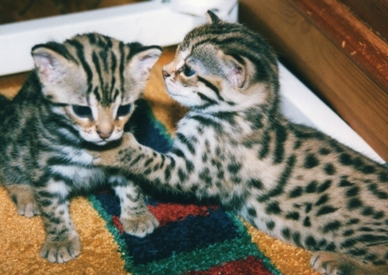 1s
are the rarest and the most magnificent variety of this breed and for
Sarah and me, living with ours is an awe-inspiring experience.
However, they are not for everyone - they are quite specialised,
simply because they’re a bit different. A true F1 enthusiast
should not expect the cat to change to fit their lifestyle, but
rather is willing to change their lifestyle to accept the behaviour
of the cat.
1s
are the rarest and the most magnificent variety of this breed and for
Sarah and me, living with ours is an awe-inspiring experience.
However, they are not for everyone - they are quite specialised,
simply because they’re a bit different. A true F1 enthusiast
should not expect the cat to change to fit their lifestyle, but
rather is willing to change their lifestyle to accept the behaviour
of the cat.
Sarez Nema (Left) & Ebony (75%
W/B F1s) - Aug. 2001
Breeding F2 Bengal Kittens
Filial 2 (F2) Bengals are two generations removed from the wild, and breeding them is as complex as F1 kittens, but for different reasons; the mating is achievable if one is patient and has studs who do not mind the F1 female’s wild smell. However, the birth of the resulting F2s is not simple because their F1 mothers have some of the inherent inclinations of a wild animal, and it’s during or just after the birth when the F2 kittens are most at risk.
Thus, once an F1 is pregnant, the breeder should normally respect her privacy and keep her on her own in a quiet and secluded place. However, there are still risks involved as the mother can sometimes find it difficult to give birth and break the sacks, causing the babies to suffocate. The other fear is that the F1 female may kill her babies if she feels threatened and although this sounds cruel, it frequently occurs in the wild as it keeps their babies away from predators and it also protects the mother, enabling her to go on to breed again.
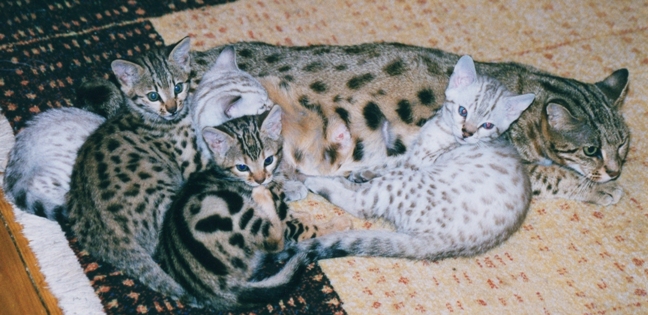 Luckily,
the birthing process is far easier for us because our F1 females are
friendly. So strong is my bond with
Leopardette that she will only
give birth if I am present and she will
actually hold back labour until I am with her. When I arrive, she
finally relaxes and gives birth (sometimes on the bed next to me) and
I stroke her, comfort her and then I help her clean the kittens. And
some of our other F1 females also allow me to be present and to help
as well. This shows astounding love and trust, and is
very unusual
behaviour because their wild cat instincts should dictate that they
seek solitude. However, most of the time Sarah can’t be present
and doesn’t disturb the mother or her babies until they are
older.
Luckily,
the birthing process is far easier for us because our F1 females are
friendly. So strong is my bond with
Leopardette that she will only
give birth if I am present and she will
actually hold back labour until I am with her. When I arrive, she
finally relaxes and gives birth (sometimes on the bed next to me) and
I stroke her, comfort her and then I help her clean the kittens. And
some of our other F1 females also allow me to be present and to help
as well. This shows astounding love and trust, and is
very unusual
behaviour because their wild cat instincts should dictate that they
seek solitude. However, most of the time Sarah can’t be present
and doesn’t disturb the mother or her babies until they are
older.
Leopardette (F1) & Sarez Ramani, Honey Bee, Anjali, Mallika (Left to Right - F2s) - Circa Nov. 2001
The average F1 will only have two to three kittens per litter, perhaps once a year, mimicking the low birth rate of their wild forbears. But again, Sarah and I are fortunate in the number of F2s that our first generation females have; sometimes as many as five kittens per litter - Leopardette for example, frequently has four babies.
With most our F1 females, I handle the F2s from day one, but on the odd occasion that the mother prefers privacy for a few weeks after birth, I leave her alone and Sarah and I interact with her kittens (under her watchful gaze) when they’re 3 to 4 weeks old. Even a nervous, first-time mother is quite relaxed by then and more amenable to us handling them.
Upon visiting our home in 1995, Jean Mill, the predominant founder of the Bengal breed, told me: “If an F1 is difficult, take her babies away at four weeks old otherwise she tells them wicked things about people, and makes them behave badly”. A charming way of explaining an important point regarding wilder F1 mothers… but I felt proud that due to the temperaments of our cats, we almost never have to do that.
For those buying a pet, looks-wise, F2s follow close behind their F1 parent, but as they are more accepting of strangers, are less intense and not as highly strung as some F1s, they make a wonderful compromise between first generations and the less wild looking SBTs. However, due to the scarcity of F1 females and the risks that F2s face when young, second generation kittens are also rare.
Physical Characteristics of F1 and F2 Bengals
F1s are generally smaller than other generations because of their tiny leopard cat father and they also share many of his wild features. On the other hand, F2s can be far larger than other generations and this is due to the quirks of the hybridisation process. They too have strikingly wild features, but they are not as prominent as those of the direct hybrids. From 5 days old, one can see that the faces of the F1s and F2s look very different to the SBTs; they have large nose leathers, puffed cheek pads, deep chins, perfectly round eyes and tiny rounded ears.
Sarez Shabok (F2 Male)
- 28th August 2001 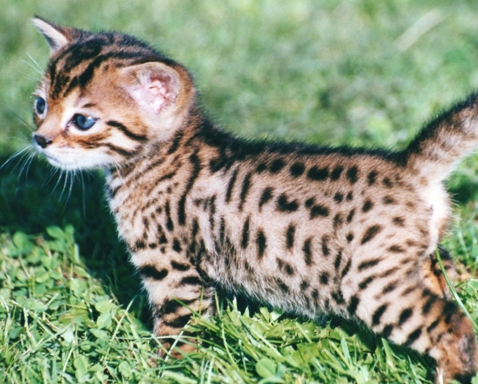
However, if one holds the kitten and gently twists him, then the guard hairs lift up and the definition can be seen from the rear. Filial generations go through a more extreme version of the fuzzies compared to SBTs, as they are closer to the wild. Some confuse this coat with white ticking however, there is a huge difference between the two and a ticked kitten will stay that way for life. The glitter gene creates the opposite of ticking and stems from one of Jean Mill’s domestic foundation cats called Millwood Tory of Delhi, and it makes the coats sparkle like gold!
The leopard cat has blessed both F1
and F2 Bengals with its luxuriously plush coat. Brown spotted filial
Bengals have light backgrounds that are adorned with large, near
perfectly formed rosettes and well spaced backward arrow shaped spots
that resemble thumbprints. And whilst most SBTs have cream or
off-white spotted chests and bellies, those of F1s and Satin (F2 Female) -
Circa February 1998 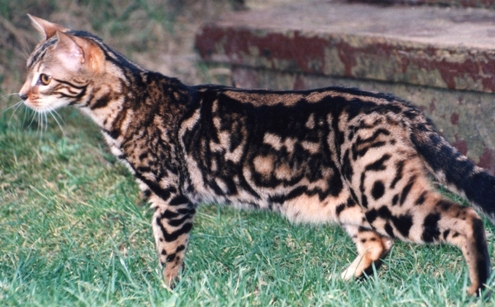
Eppie (F2 Female) -
Circa August 2000 
Whilst many late generation Bengals have wonderful coats with superb markings and contrast, I am yet to see one that is quite as leopard-like as that of an F1 or an F2.
Other Characteristics of F1 and F2 Bengals
F1s and F2s don’t just inherit the cosmetic look of the wild cat; they yowl rather than meow, they hunt their toys rather than merely playing, they don’t walk but prowl and they trot and gallop rather than run. Even when standing, their stance is that of a wild cat - SBTs do share these traits, but they are all more pronounced in these two early generations.
Baby Gem (F1 Female) -
1995 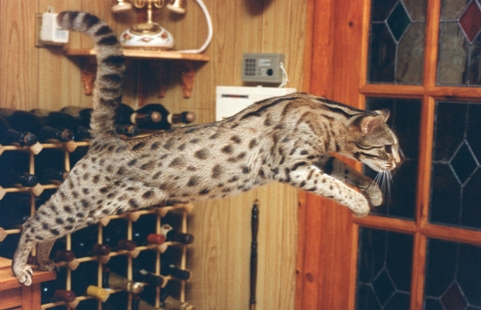
Another characteristic that F1 and F2 kittens have copied their wild forefather is that they gorge themselves until their stomachs resemble huge barrels, and growl loudly to warn off as many of their litter mates as they can - so sweet. This is what the cubs do when their parents have killed prey in the jungles… their natural instinct tells the cubs that this could be their last meal until their parents kill again.
A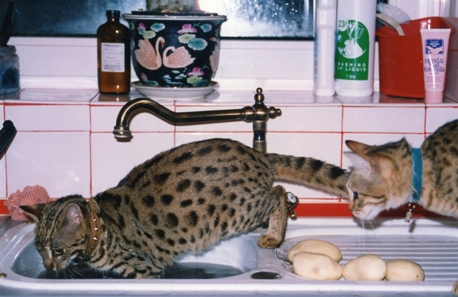 ll
Bengals adore water, but F1s and F2s love it more than SBTs. Ours
jump in baths with us, they get in our fish tank and they swim in
ponds, if given the chance! They drink from running taps, they play
with the potatoes as Sarah is trying to peel them, and even dunk
their food into their water bowls before devouring it, just as the
wild cat does. And several of our early
generation Bengals have learnt how to turn the taps on and then go to
the toilet in the sink, again, just as the leopard cat does in
streams within their natural habitat.
ll
Bengals adore water, but F1s and F2s love it more than SBTs. Ours
jump in baths with us, they get in our fish tank and they swim in
ponds, if given the chance! They drink from running taps, they play
with the potatoes as Sarah is trying to peel them, and even dunk
their food into their water bowls before devouring it, just as the
wild cat does. And several of our early
generation Bengals have learnt how to turn the taps on and then go to
the toilet in the sink, again, just as the leopard cat does in
streams within their natural habitat.
Occie (F1) Playing with the
Potatoes! And Tinker - Circa Spring 1994
Our Hybridising Leopard Cats and Their Offspring
Sarah and I were so enthused by the love of our first three F1s that our dream quickly became to hybridise and create more of them. This felt like a natural progression for our early generation breeding programme, but we knew that it would be extremely difficult, very expensive and tremendously time consuming.
And so over the years, we bought and bred around 15 leopard cats, keeping our adults in large, luxurious outside enclosures on our estate, and the cubs that we hope will hybridise (common subspecies only) are hand-reared in our home, living alongside our Bengals.
Then, in 2000, one of our leopard cats, Sarez Little L., became the first to hybridise to a domestic cat in Britain, producing a magnificent litter of F1 Bengal kittens! Naturally, we kept the two beautiful females Meena (Sarez Sanura) and Keesha (Sarez Safiya). And then in 2004, a second leopard cat, Sarez Apollo, followed suite!
Sarez Little L.
(Leopard Cat Stud) - Circa 16th December 1998 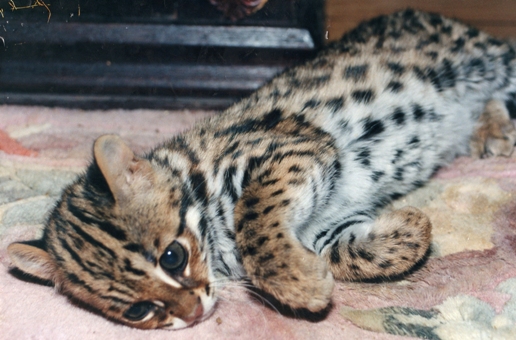
Only a few breeders in the world have succeeded in hybridising from one leopard cat, and just a tiny fraction of them have hybridised from two of these creatures! And so Sarah and I are thrilled that all our hard work paid off; and we are so very proud of our leopard cats.
Our 75% and 90% Wild Blood F1 Bengals
We also breed higher wild blood F1s in the hope of one day breeding late generation Bengals with more leopard-like faces. Britain’s first litter of 75% wild blood F1s were the progeny of our F2, Eppie and Little L., and included a stunning female who we called Sarez Ebony, whilst a repeat mating produced another breathtaking female who we named Sarez Pow Wow. We reared the babies in our bedroom, we helped to feed them when they were tiny, and we spent a great deal of time with them as they got older, all to help override their heightened wild instincts.
In 2003, Sarah and I took this one stage further and bred one of our high wild blood females, Pow Wow, back to the leopard cat and created Sarez Zeus, who’s believed to be the world’s only 90% wild blood F1. Again, this ultra wild looking cat was handled intensively from birth and today he remains as tame and as friendly as most domestics are.
Sarez Zeus (90% Wild Blood F1) -
26th August 2003
We had hoped we would breed a 90% wild blood fertile female, but that was not to be, and due to the extreme complexities of breeding Zeus, it’s unlikely that another will be bred again.
What Our Bengals Do for Us and the Breed
Using the income from our kittens, Sarah and I set up the Sarez Animal Rescue Sanctuary in which we take everything from pigs, to deer and donkeys, and we also created the Sarez Wild Cat Conservation Programme in which we keep African leopards, ocelots, servals and the rarer subspecies of the leopard cat. And we want to obtain other endangered wild cats and aide their conservation as well.
Our cats help other conservationists, too. Dr. Andrew Kitchener, curator of the National Museums of Scotland studies our F1s to understand how two different species can reproduce, then he uses his findings to help very rare species. There’s even a small part of the museum dedicated to us and our hybridisation work.
Our Bengals are great ambassadors for the breed as well, appearing on about 35 TV programmes and in over 100 national newspapers and magazines, including many front page cover stories. They’ve also advertised Armani, Versace and Cavalli in Vogue Pelle, Tatler and Country Life and have made appearances on fashion catwalks, enticing many famous celebrities to purchase our kittens, from Lord Jeffrey Archer to Jonathan Ross.
Such media coverage draws the public to the breed and helps to educate others on how trustworthy all the generations of the Bengal can be.
Leopardette (F1
Female) - Circa July 1996 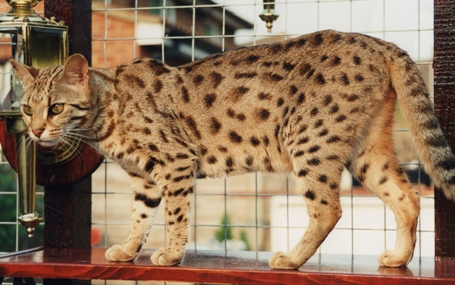
And the results are the astonishing filial Bengals - the building blocks of our pedigree breed. Some within the fancy disagree with their use and with hybridising, but it does not take a genius to realise that breeding from early generations can only benefit all Bengals by re-introducing the leopard cats inherently superior genes, by preventing inbreeding and by emphasising stronger, wilder features in all later generations. It will be a long time before these traits are so strong in SBTs, that the leopard cat is not needed.
I love all cats, but to me, the entrancing F1 and F2 Bengals are special. Ones that have been well bred and socialised encapsulate all the best features of both the leopard cat and the domestic cat. They’re also majestic and regal creatures - and even though sensitive, they’re proud as well… they choose to be loyal and to love their families on their terms, not on anyone else’s. And ours have honoured both Sarah and I with just that. And we know that their strong trust and love for us, is indeed the greatest compliment of all…
C. Esmond Gay
Sarez Bengals
Copyright 2004 C. Esmond Gay
Dedicated to Leopardette - I love you
Retirement Addition (2008)
Sarah and I achieved a phenomenal amount during the 11 years that we bred Bengals and many of our accomplishments are still unsurpassed. We obsessively chased every one of our goals and ambitions and didn’t stop until we had succeeded. And everything we did was meticulous and done to perfectionist standards.
However, this entailed working up to 18 hours a day, 7 days a week, and with few breaks or holidays. In hindsight, we did too much too fast because the enormous stress that we put ourselves under, plus looking after hundreds of animals almost single-handedly, took its toll on us mentally, emotionally and physically. By 2004, Sarah and I were suffering from severe exhaustion and so reluctantly, we retired. We hoped to lead a quieter life in Latin America, living and working with their endangered cats.
Our larger wild felines went to wildlife parks, our rescued animals went to sanctuaries and private homes, whilst many of our Bengals and leopard cats went to Pauline and Frank Turnock of Gayzette Bengals - they look after and nurture our cats, and are expanding the breeding programme that we worked so hard to create.
I stay in regular contact with Pauline and Frank and offer them my support and advice on the Bengal and wild cats. I follow their achievements, and behind the scenes, I am there for them and for the beautiful cats that we once so proudly owned.
To Sarah and me, our cats were more than just pets or breeding animals - they were our family. And within the articles I wrote, my deeply emotional descriptions of them and how they influenced our lives, portrays just how powerfully I love them; and so naturally, I feel terrible loss and miss them tremendously. However, I am grateful for the 11 wonderful years that they graced our home, and for the honour and privilege of being able to share part of my life with them… and for the amazing memories that they’ve left me with.
C. Esmond Gay




